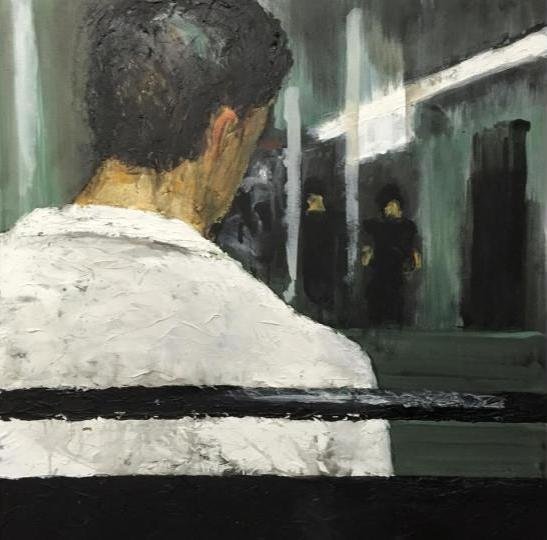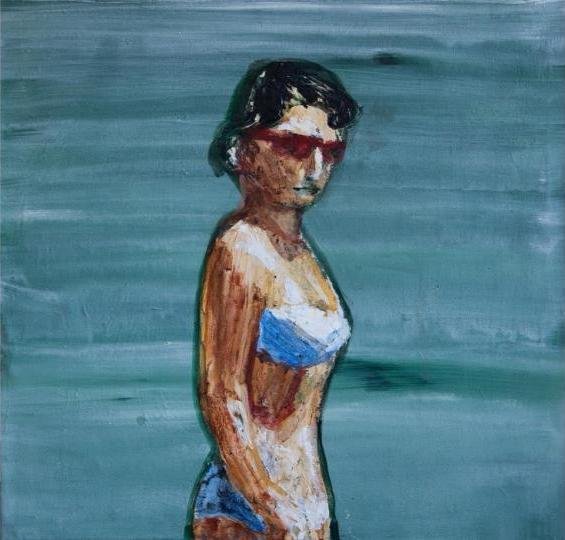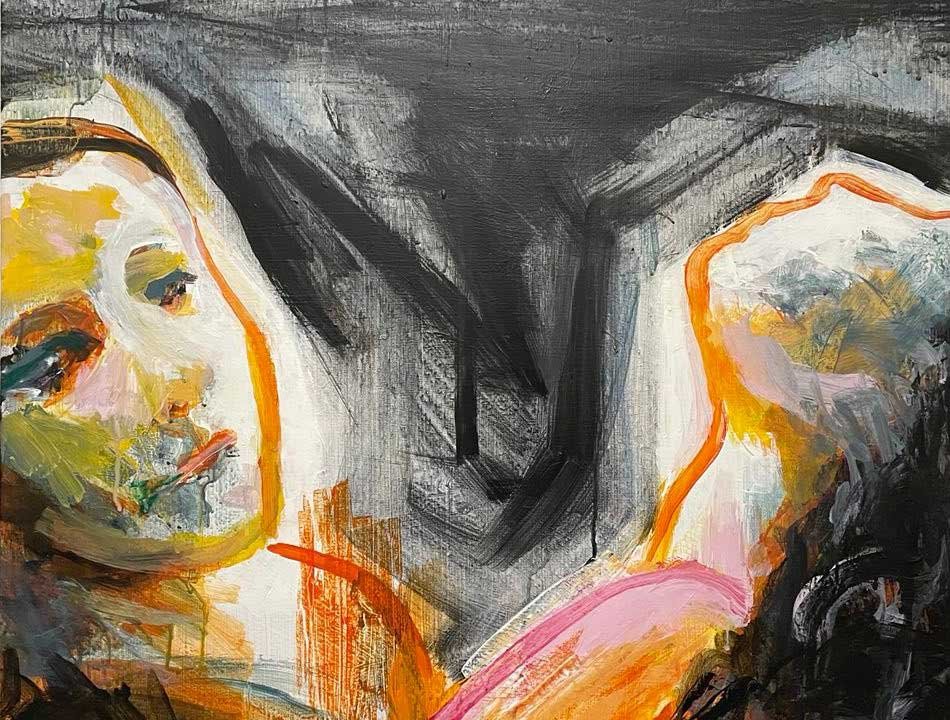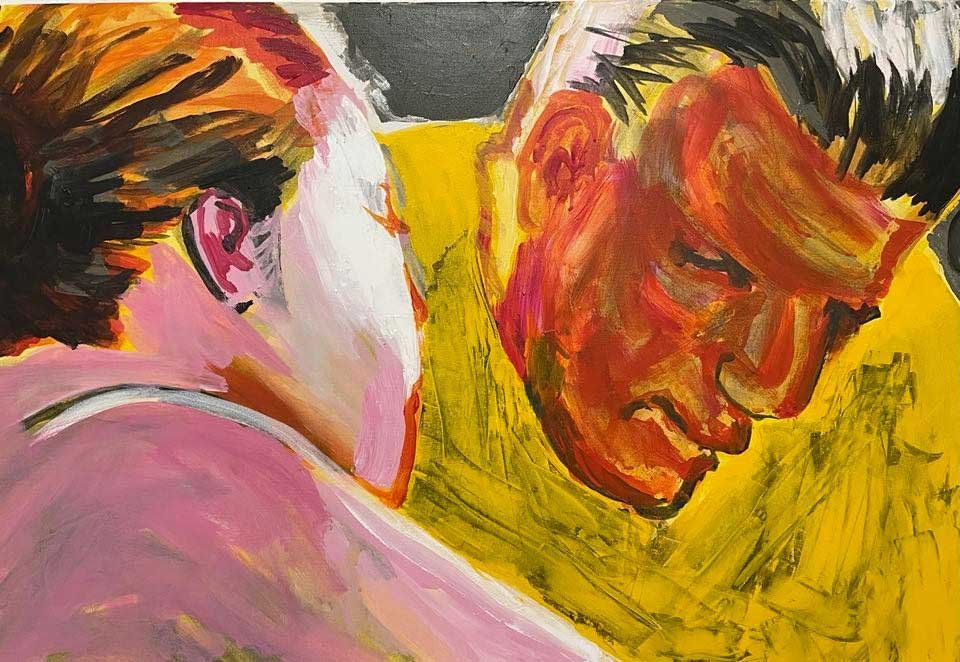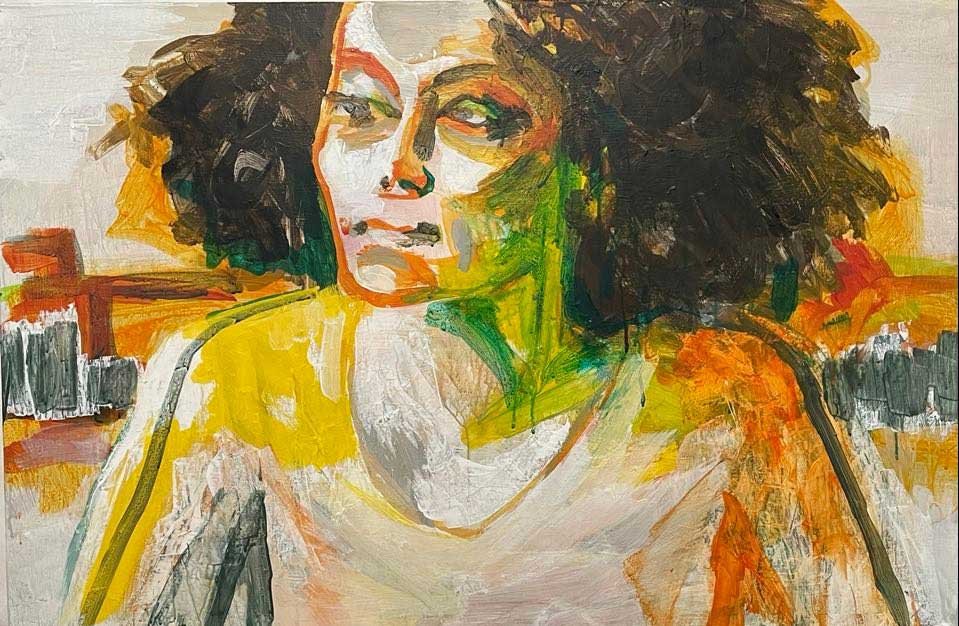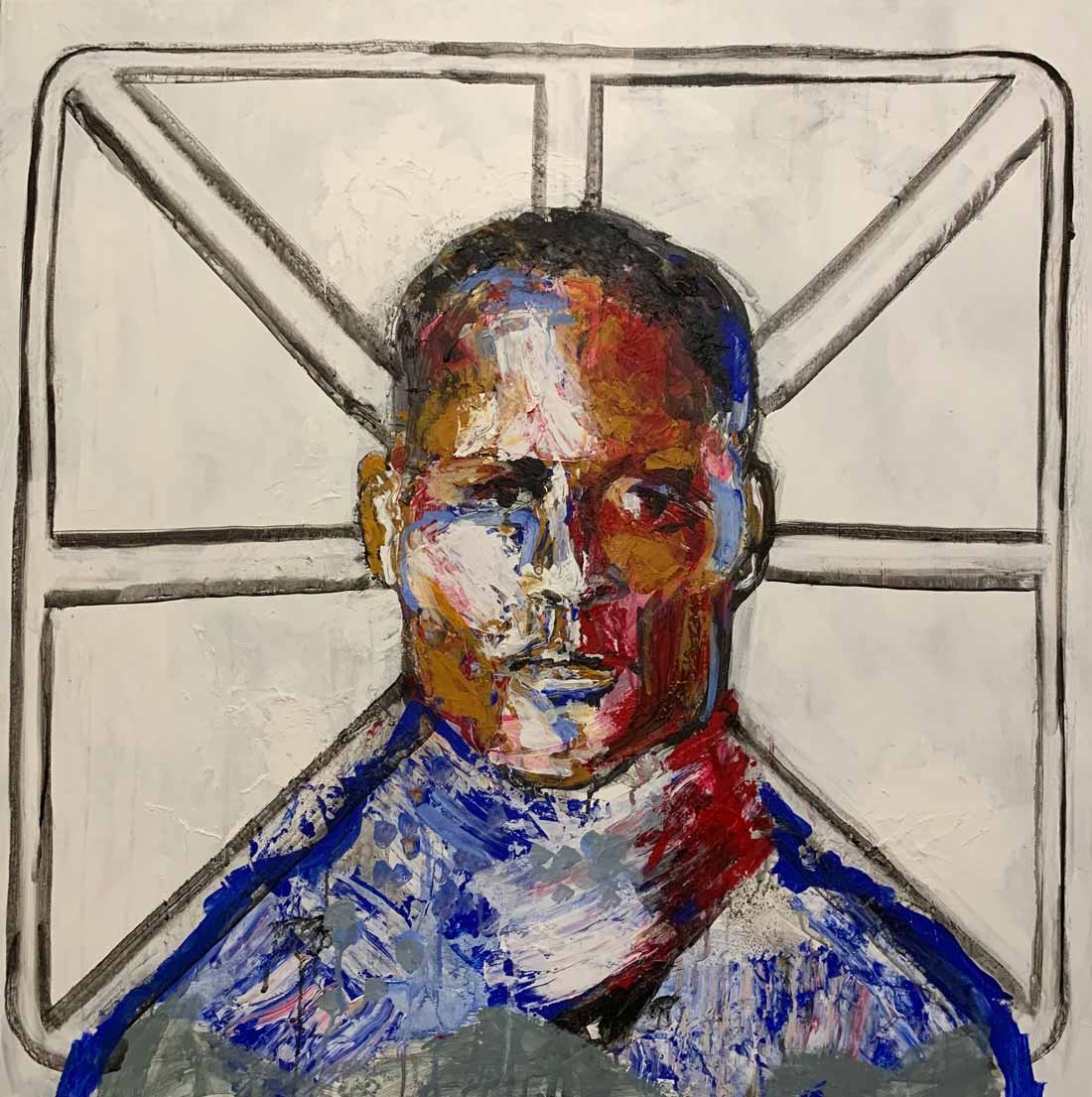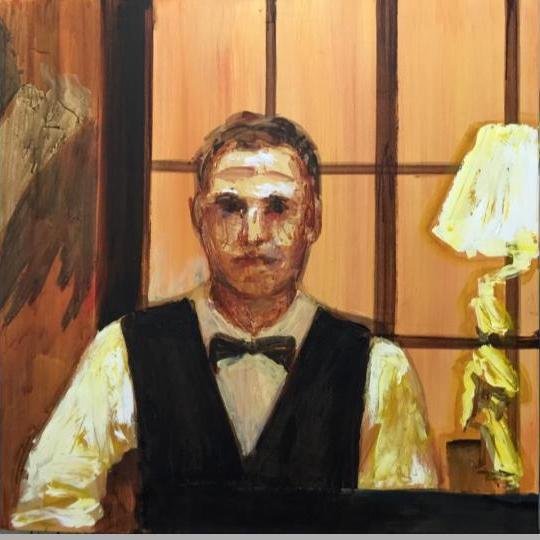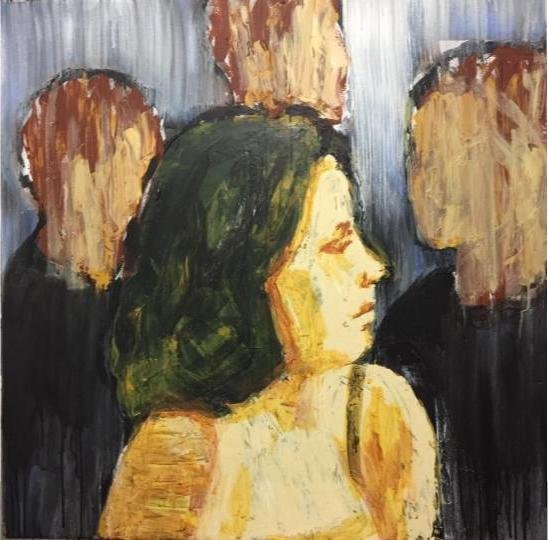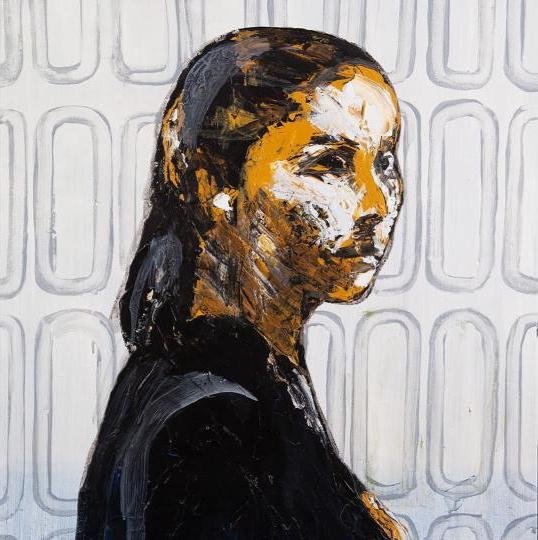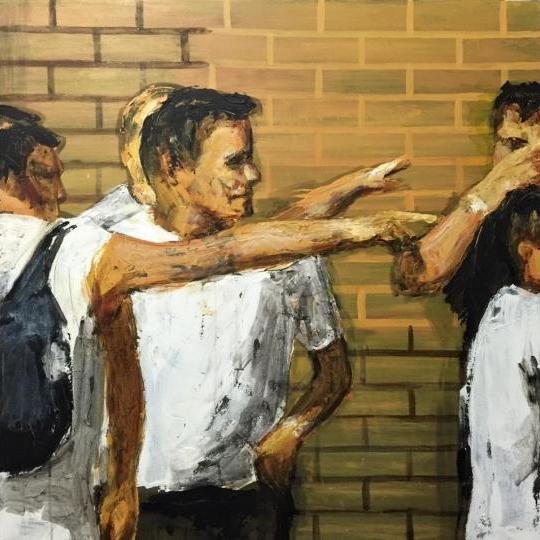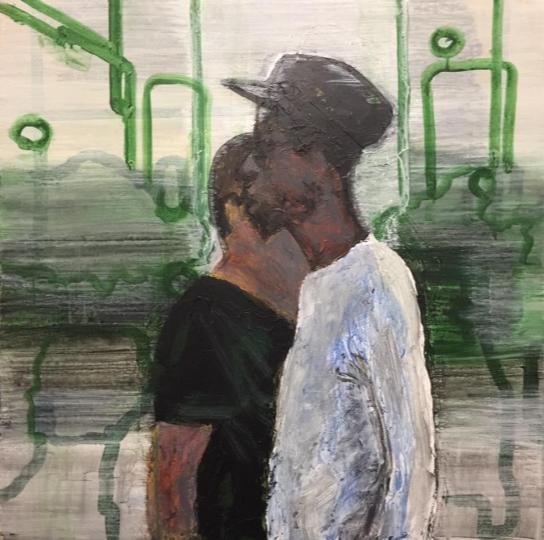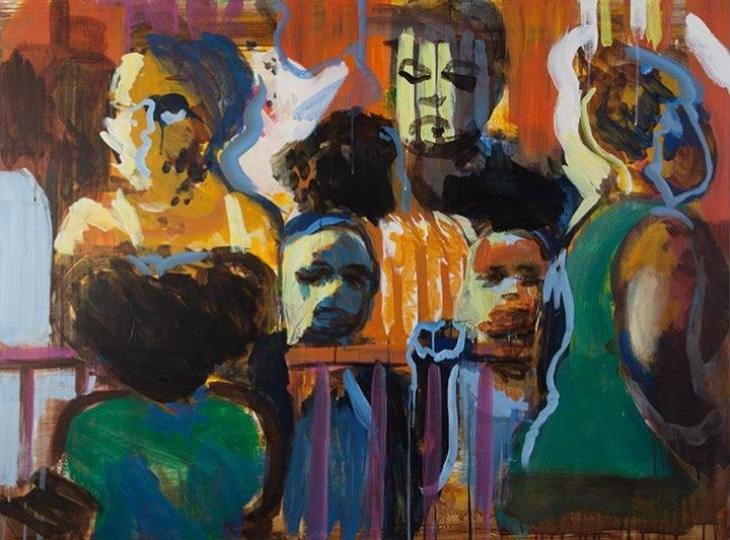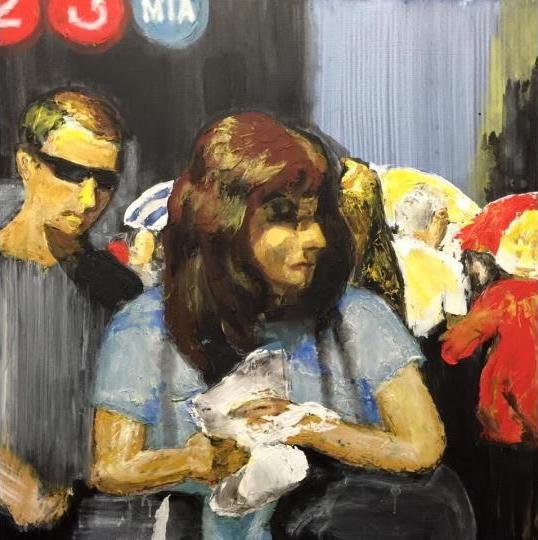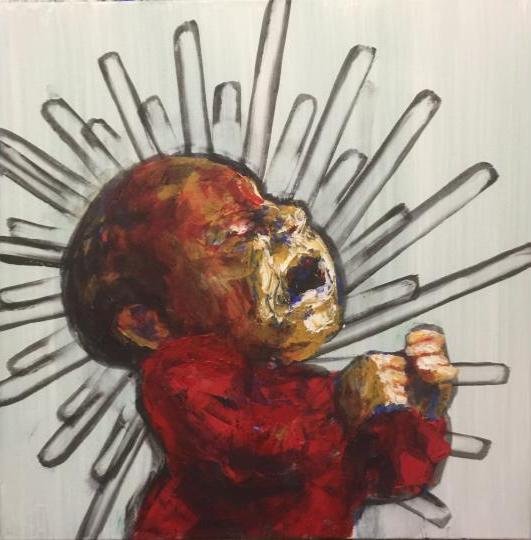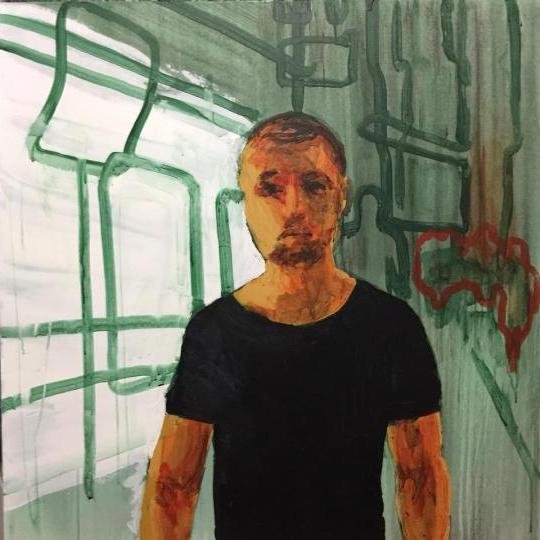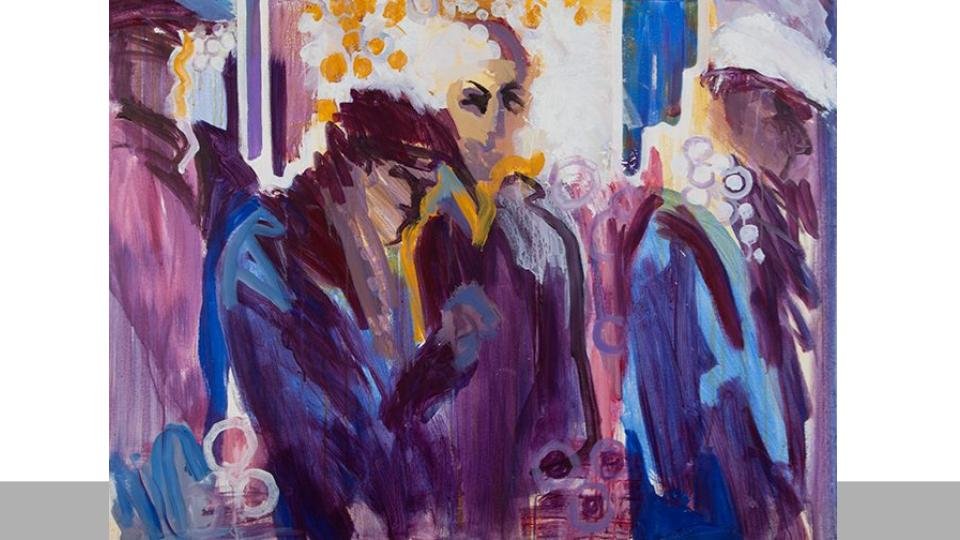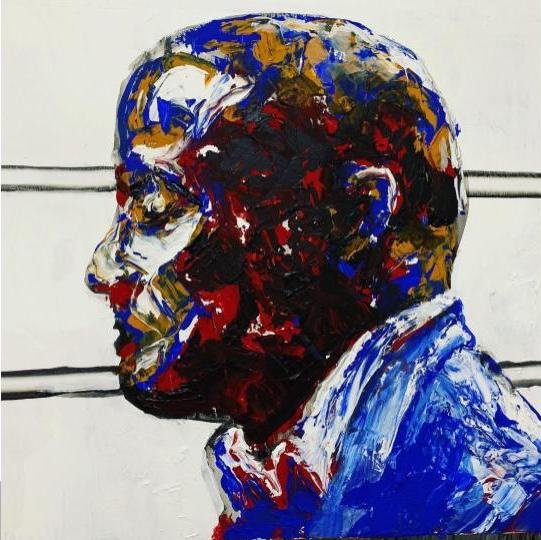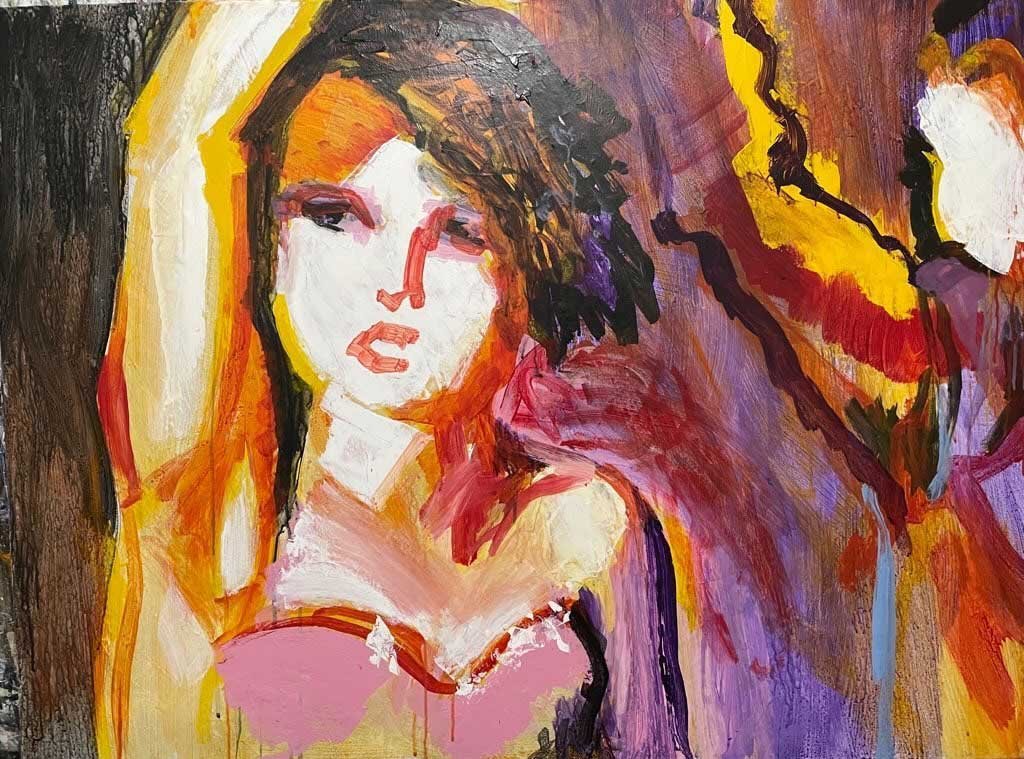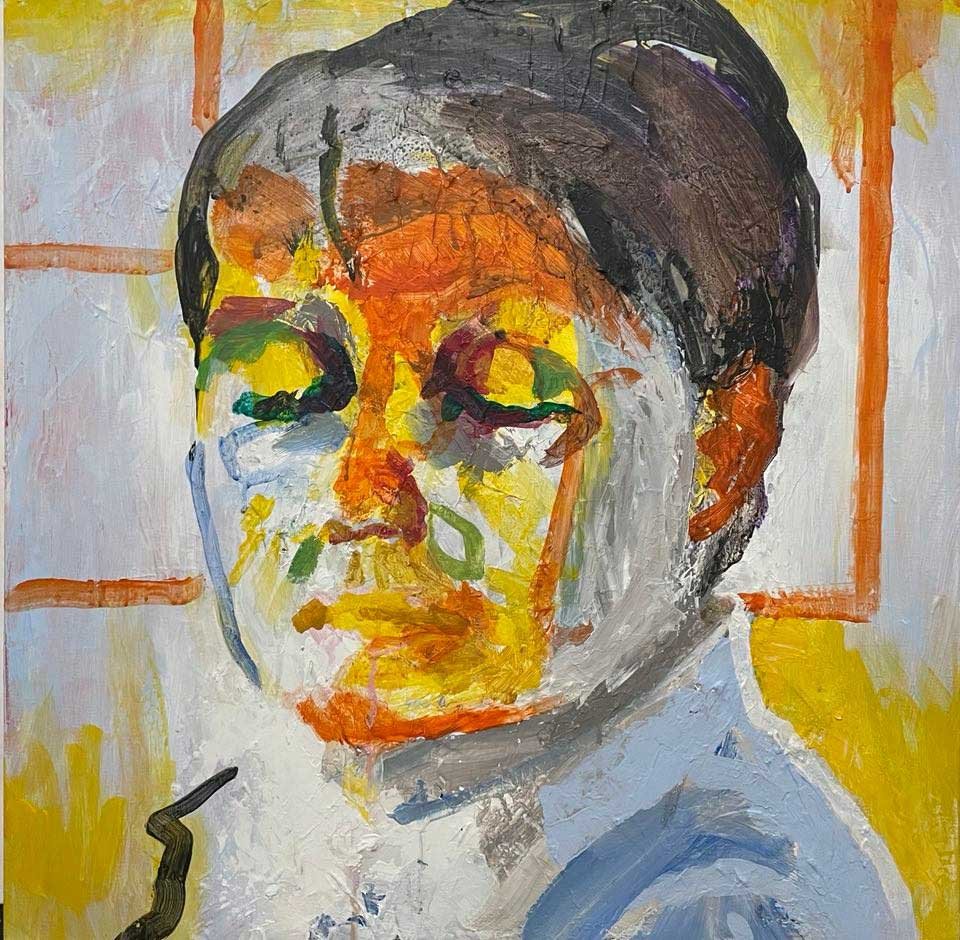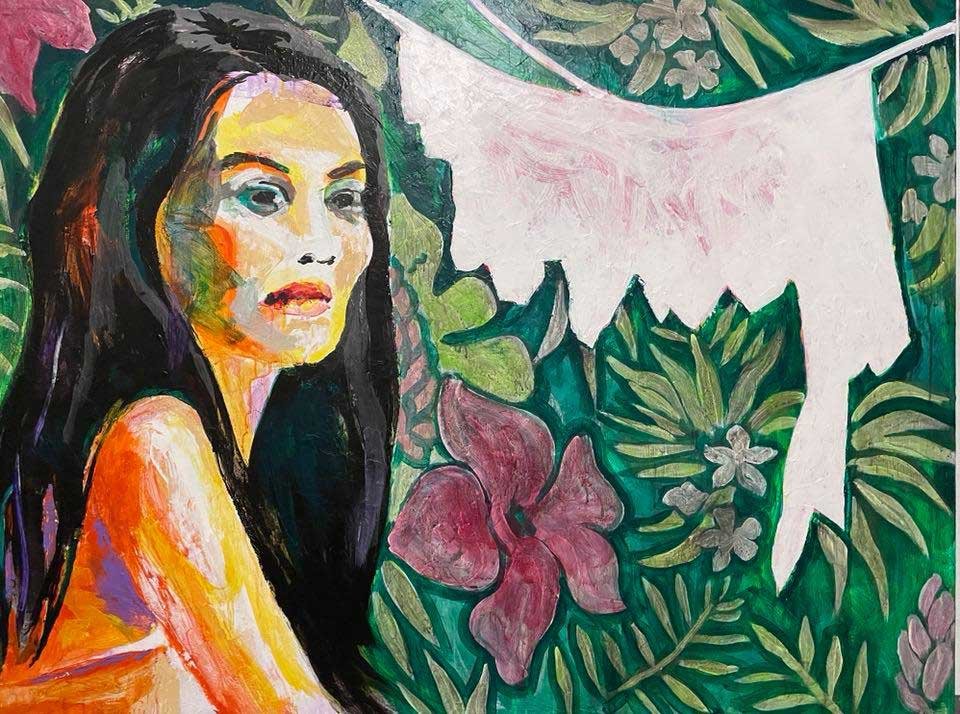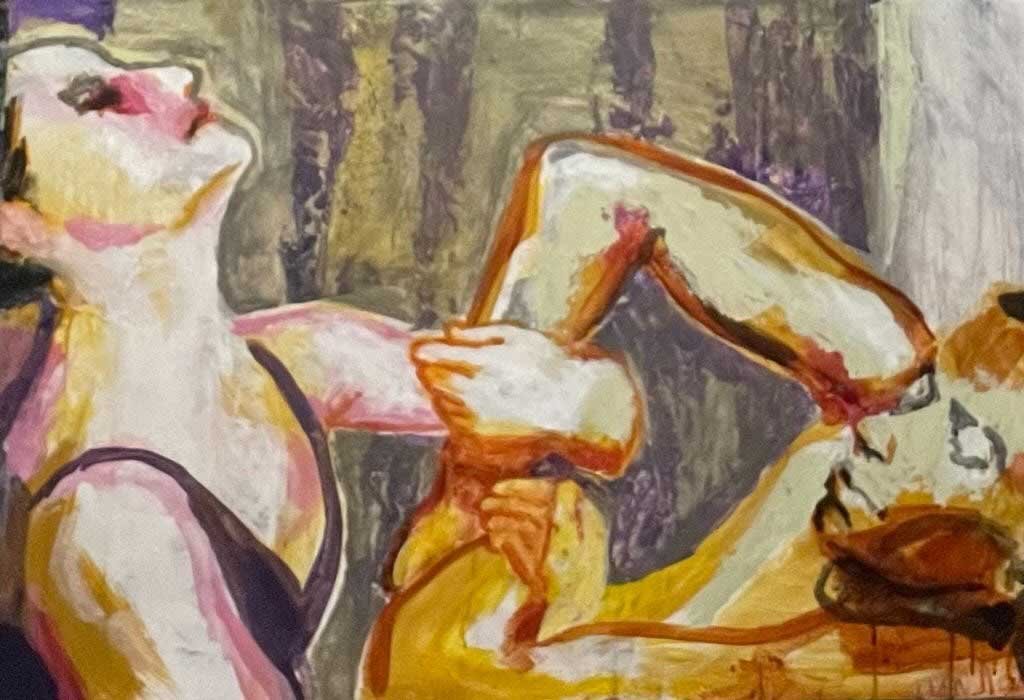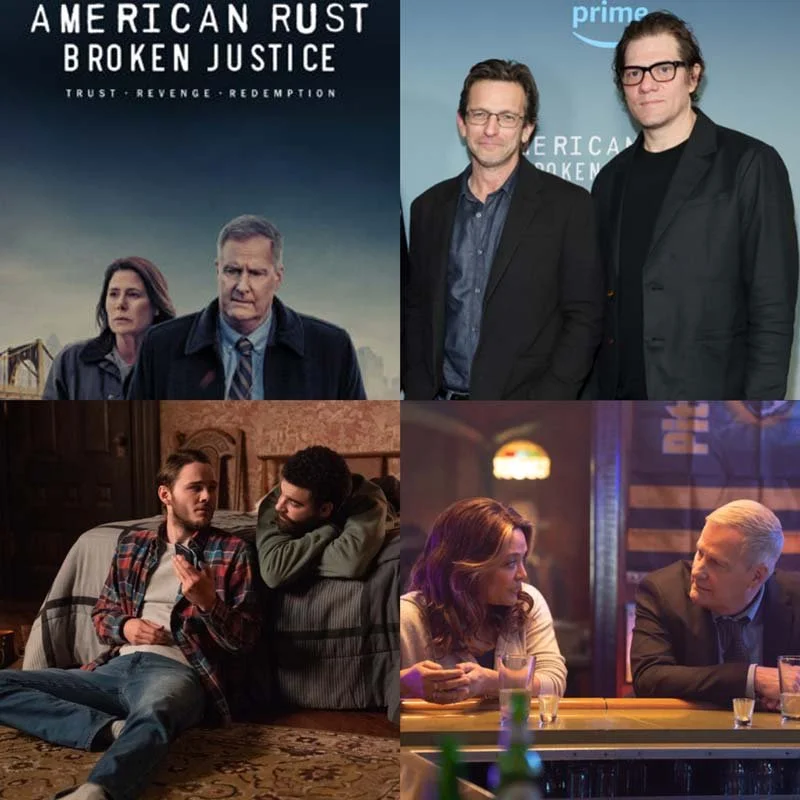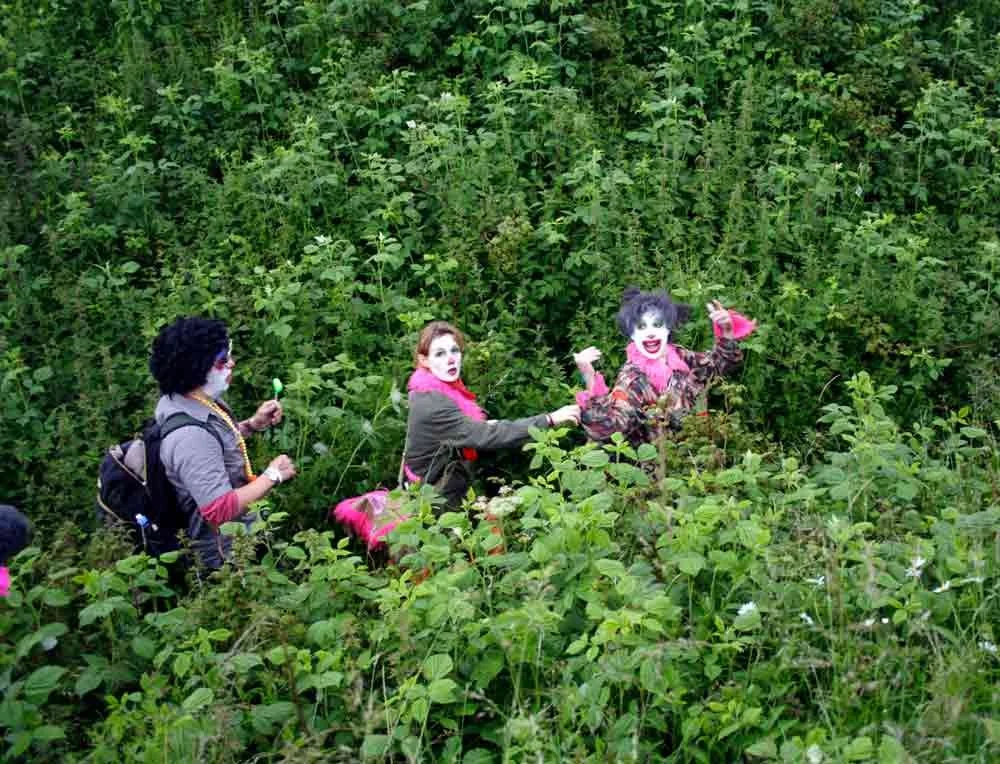Gloria Pacis is a painter dividing her time between New York City and Hoboken, where she has her studio. She received her BFA from the University of Washington in 1976. She credits her years working as a set designer and scene artist for the dramatic, character-based elements of her paintings. She has participated in exhibitions at public institutions and universities, including Wing Luke Museum, Mana Contemporary, University of Washington, Henry Art Gallery, Monroe Center for the Arts, Seattle University, ACT Theatre, and Seattle Center Art Museum, where her work was chosen to showcase International Women’s Day. She has designed sets for many leading theatres, including notable productions of A Christmas Carol, Hamlet, The Doctors Dilemma, Hedda Gabler, and Salome. IG @gloriapacis
THE CREATIVE PROCESS
How did you come to this connection with the characters that you paint?
GLORIA PACIS
I just feel there is already a connection, something I have to come to, but that I'm trying to search it out or see what's already there. I feel that we are truly connected as a world. And I'm just trying to make people aware of an existing connection we already have, to send that message out there. And I like to do it in the form of...I guess you'd call it a mundane image, where it's not really about bells and whistles, but it's about something in it makes you want to look, and you want to know why. And it's because you've been there before, regardless of whether you are a dancer or that particular guy in the subway, you know you've been in his head in that mood that he's experiencing.
*
I've always been fascinated by the interaction of people and why they say and do the things they do. And I could see how theater impacted my work because actually, I have a broad brush when I paint, mainly. And it gets kind of fuzzy as you get close, but as you go further, you see things. That's the discipline of the theater. You're painting up close, but for an image that can be seen from a distance, from the last chair in the theater. So that's kind of my thing.
I've got to say, I'm particularly interested in murder mysteries myself. If I were to watch the TV, it's because at the end, they round it all up and they find out who the killer is. Because murder mysteries, more than any other story, they answer the question: why did this guy do this? And that's what I like, to answer the questions of why people act the way they do it. Now you can find that regardless of what the theatrical production is about. I tend to like classic stuff, but I can't imagine a more fascinating topic than people and what moves them. What makes them act the way they do? I just can't think of anything more interesting. And the goal of my work in particular is to make people just stop enough to look at it and then be reminded of themselves a little bit in what they're looking at, regardless of what they look like compared to the image. And that's it. Sometimes I'm just sitting at a coffee shop, watching people and trying to invent stories. It's just a fascination for me.
*
Sometimes I'll paint images of people watching a parade go by, but nobody takes the pictures of the crowd watching. And just to focus the attention on: this is what you're missing. I like to do stuff like that. And it's just to draw attention to an aspect of humanity that I'm just trying to make people pay attention to, that's all. Like sometimes walking through Times Square, you see all the razzle-dazzle, and then every once in a while you see a dilapidated little section of Times Square. And I'm going: look at that. That's a good...nobody's noticing that. I don't know what it is, my fascination for just zeroing in on stuff that nobody will look at, but I just like that, you know. I'd like to say that another artist I like is Rothko. And my opinion about him is that I just can't help but get sucked into his pictures. I just stare there for the longest time. Everybody has moved on, and I'm sucked in. I want to achieve something to stick people in that place. Just keep them still for a second.
*
It's because I consider life a dance, really. A dance. Some dancers are clunky, and some dancers are graceful, but it's a dance, a compromise, a puzzle, kind of, and it just has a lot of elements that I can draw comparisons with life. You know, the dance of the planets. There are so many dances all the time, all around us. And do you know what they're all saying? Yes, no, maybe...but that's what we're in. And we're trying to figure out why are we here? Why do I have to do this dancing? And what's animating me? I just like the way there are a lot of analogies between life and dance, between the way people interact. You know, people who are not dancers. I just like that. Lines can be drawn between regular life and dancing. But also the advantage that this art has over dance is it freezes the moment. A moment you miss because time goes by and the dancer has got to keep moving, but you miss something unless somebody freezes it.
You could kind of compare it to planets in space or two people just going around the planet, wondering...just the daily grind of the beginning of the day to the end. We're twirling in space. The planet is in itself, twirling in space, twirling around. And I just want to give people a sense that we ourselves are planets.
*
And there's just a lot of expression that you can get from looking at the face, which is why there's a concentration on the face. And I use colors to evoke a mood, and I feel like the reason I paint is about not showing an image, sharing an image, sharing a likeness. It's about the mood of that person. And you can't get into a mood as good when you're just trying to nail down a likeness. You get it because of the way you feel towards it. The colors that you are inspired to paint as you look at it, and in my practice, I'm just more drawn to the inner life of that person and expressing it. And so there's no need for me to get into likeness.
*
I use whatever I can do to see something besides the obvious. And you do that by squinting, by half looking. You just go into it, not as you faithfully copying something, but just going with it. And from a distance, you know, this doesn't look as exaggerated as it does when you're close up, the exaggeration of color, of dark and light, but training in the theater arts just makes you more aware of basic shapes and how they're going to read from the distance.
And another thing I was trained in - getting the composition, not right, but just balanced. Balanced composition, that takes the precedent. If you don't have a good composition, forget about the rest. So I work the composition until it works. And then I go from there. But in that regard, you could say I am old-style. Because that is what starts a painting and ends a painting. The composition, the bones, the frame on which the whole thing rests has to be good.
*
This is called The Dancers, and this is part of my dancing series. And you could interpret this as two planets twirling in space, and it kind of evokes the question of what are we doing twirling in space, but it all started from just the idea that I've got to paint this. And this, of course, was just a small picture of the entire image. You know, I'm just watching it on TV, and I take a shot. And I go, you know what? The only thing I like about this whole thing is the two heads. So I squished them together a little bit, and that's it. And it appears now as if there are two planets floating in space. And it evokes existential questions, but that was the purpose of that.
THE CREATIVE PROCESS
And also, as I look at that, it could be the same person because you have this connecting line. So in my interpretation, although I can understand that they're dancers, they might be two versions of the same person. One, the watchful aware one. The other one, in abandon or passion or this more free gesture. That's just something I get, and there's maybe a dark mirror between them. There are multiple interpretations, which is all so lovely about your work. Or even, they're lovers? I'm not sure, and that's what I like because you don't answer all the questions.
PACIS
And I try to make my figures not so gender-specific necessarily. Sometimes you can guess, but the image on the left was actually a man. You can't tell really. And the right one was a woman, but the idea that they could be the same person is...I'm just very fascinated also by the whole idea of what gender is because in my head I'm kind of masculine. I don't comport myself as transgender or anything, but I think I operate in the world like a male in a lot of respects. And I just want to bring that out that I think a lot of people do this. They're not, they might look female, act male in a certain way, under a certain spectrum. It's a very fascinating age we live in. It's as if we're just being made aware of all these things that were already there. That we are on the spectrum of things, on the spectrum of female, on the spectrum of male. And then we look a certain way outwardly that's all that is. I think I'm basically, heterosexual female is what I still do, but I know when I'm just by myself, I don't even think of myself as a pronoun. I just think, Hey, this is…I am me in the world doing me things.
*
The 50s and 60s were a more repressed time. People were kind of expected to be sunny on the outside. Going to a therapist was frowned upon. It was like a source of shame. Now it's just an open thing. I'm a baby boomer, you know, and then after that era, we became hippies. And then after that, we became new age, whatever. And everything they say about that time is true. It produced a lot of artists that just want to break out and be free. I couldn't understand why people would want to be bottled up. As a child, I saw a lot of sad things happening, and I was wondering, can I be the only child that sees how ridiculous the adults are? So when I became an adult, I thought, dang it. I'm going to expose everything. And I don't think I'm any different from a lot of artists that just want to break out and be free. That's it.
*
It is still a scary time we're in. And there's a lot of fodder for artists to use towards their art. It's just a very transitional time.
THE CREATIVE PROCESS
And you yourself got COVID. It was a very scary time for you. And you were hospitalized. Tell us a little bit about that experience and maybe how it reordered the way you prioritized things or maybe got back into your art in a deeper way.
PACIS
Well, there is a setback after having COVID. You just don't have the energy to do stuff. And whenever I have a period of not working on my work, then I come back with a vengeance after I'm able to. Actually, before I got COVID, I was happy that we were sequestered, that the whole world was sequestered. I'm doing artwork, but the actual COVID experience, you know, it got you thinking why it's happening and why it's happening now. As you could see in the painting, there's a lot of red and blue. The blue is left-leaning liberals, and the red is right-leaning conservatives. And as you see, she's mixed, she has it both in her. It's how I see the world that we're in, that there is a major reset we have to do. And we all just have to get along. And we all have elements of both liberal, conservative, practical, and idealistic in us. Not, of course, that we should welcome somebody like an extremist into our lives of either party, but that is what we're in. Now back in the fifties and sixties, it was the Republicans and Democrats in the United States, they weren't as combative as they are now. There was a lot of agreement. There was like a foregone conclusion, they're all going to pass the Civil Rights Act, but now every little thing. And part of the reset button is people understanding that they can now not just rely on government for everything. If they're so undecided, the smartest heads in the room can't figure it out, we have to do our part to just reach out and see how we could help somebody. You know, as long as they're not a guy with a semiautomatic, just reach out and look at them as a person.
*
It's exactly the spirit of an artist that a lot of people have kept, and it's a lesson in that we should keep, that ability to wonder, the freedom to recreate something to our image, to our way of seeing the world. That's all good, and that's what a child does without knowing, but it's to retain a bit of the child. It's a necessity.
*
Well, I think it was a process when I was little. I was always living in my head and not being in the moment because I'm not hearing what people are saying, but trying to get to why they just said that. So, I was always trying to step back a little as opposed to getting involved in things. And I think that's kind of what meditation is. You're stepping back. Let's look back at this, set the dial to zero, and now analyze the scene in front of you. So I was always doing that then. Now I'm with a guy, another artist, Ed Tadiello is his name, and he reintroduced meditation to me. And as a person who does the standard meditation, I'm not successful all the time. My mind does wander, but I get better with practice. But like I said, the act of doing artwork, the act of preparing to do artwork is meditative. You're standing back as opposed to getting sucked along with all the baggage.
THE CREATIVE PROCESS
That's the interesting thing about when you are painting. In a sense what you do it's an act of looking, it's an act of listening, that act of seeing, and in a way, you do become what you're painting.
PACIS
Exactly. Yeah, maybe I'm just trying to walk into a painting and find myself.
This interview was conducted by Mia Funk and with the participation of collaborating universities and students. Associate Interviews Producer on this podcast was Bianca Bartolini. Digital Media Coordinators are Jacob A. Preisler and Megan Hegenbarth.
Mia Funk is an artist, interviewer and founder of The Creative Process & One Planet Podcast (Conversations about Climate Change & Environmental Solutions).




